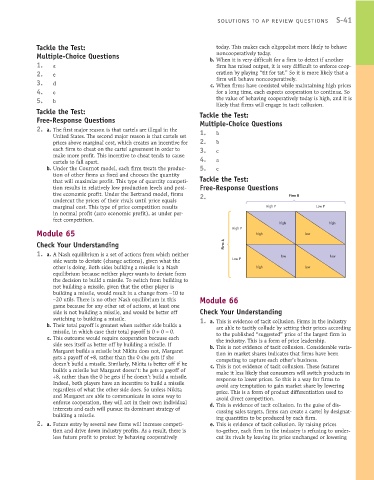Page 887 - Krugmans Economics for AP Text Book_Neat
P. 887
S-41
SOLUTIONS TO AP REVIEW QUESTIONS
Tackle the Test: today. This makes each oligopolist more likely to behave
noncooperatively today.
Multiple-Choice Questions b. When it is very difficult for a firm to detect if another
1. a firm has raised output, it is very difficult to enforce coop-
2. e eration by playing “tit for tat.” So it is more likely that a
firm will behave noncooperatively.
3. d c. When firms have coexisted while maintaining high prices
4. e for a long time, each expects cooperation to continue. So
5. b the value of behaving cooperatively today is high, and it is
likely that firms will engage in tacit collusion.
Tackle the Test: Tackle the Test:
Free-Response Questions Multiple-Choice Questions
2. a. The first major reason is that cartels are illegal in the 1. b
United States. The second major reason is that cartels set
prices above marginal cost, which creates an incentive for 2. b
each firm to cheat on the cartel agreement in order to 3. c
make more profit. This incentive to cheat tends to cause 4.
cartels to fall apart. a
b. Under the Cournot model, each firm treats the produc- 5. c
tion of other firms as fixed and chooses the quantity
that will maximize profit. This type of quantity competi- Tackle the Test:
tion results in relatively low production levels and posi- Free-Response Questions
tive economic profit. Under the Bertrand model, firms 2. Firm B
undercut the prices of their rivals until price equals
marginal cost. This type of price competition results High P Low P
in normal profit (zero economic profit), as under per-
fect competition.
high high
High P
Module 65 high low
Check Your Understanding Firm A
1. a. A Nash equilibrium is a set of actions from which neither low low
Low P
side wants to deviate (change actions), given what the
other is doing. Both sides building a missile is a Nash high low
equilibrium because neither player wants to deviate from
the decision to build a missile. To switch from building to
not building a missile, given that the other player is
building a missile, would result in a change from −10 to
−20 utils. There is no other Nash equilibrium in this Module 66
game because for any other set of actions, at least one
side is not building a missile, and would be better off Check Your Understanding
switching to building a missile. 1. a. This is evidence of tacit collusion. Firms in the industry
b. Their total payoff is greatest when neither side builds a are able to tacitly collude by setting their prices according
missile, in which case their total payoff is 0 + 0 = 0. to the published “suggested” price of the largest firm in
c. This outcome would require cooperation because each the industry. This is a form of price leadership.
side sees itself as better off by building a missile. If b. This is not evidence of tacit collusion. Considerable varia-
Margaret builds a missile but Nikita does not, Margaret tion in market shares indicates that firms have been
gets a payoff of +8, rather than the 0 she gets if she competing to capture each other’s business.
doesn’t build a missile. Similarly, Nikita is better off if he c. This is not evidence of tacit collusion. These features
builds a missile but Margaret doesn’t: he gets a payoff of make it less likely that consumers will switch products in
+8, rather than the 0 he gets if he doesn’t build a missile. response to lower prices. So this is a way for firms to
Indeed, both players have an incentive to build a missile avoid any temptation to gain market share by lowering
regardless of what the other side does. So unless Nikita price. This is a form of product differentiation used to
and Margaret are able to communicate in some way to avoid direct competition.
enforce cooperation, they will act in their own individual d. This is evidence of tacit collusion. In the guise of dis-
interests and each will pursue its dominant strategy of cussing sales targets, firms can create a cartel by designat-
building a missile.
ing quantities to be produced by each firm.
2. a. Future entry by several new firms will increase competi- e. This is evidence of tacit collusion. By raising prices
tion and drive down industry profits. As a result, there is to-gether, each firm in the industry is refusing to under-
less future profit to protect by behaving cooperatively cut its rivals by leaving its price unchanged or lowering

